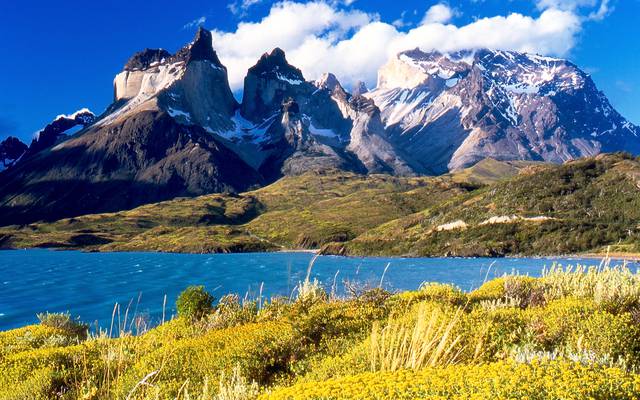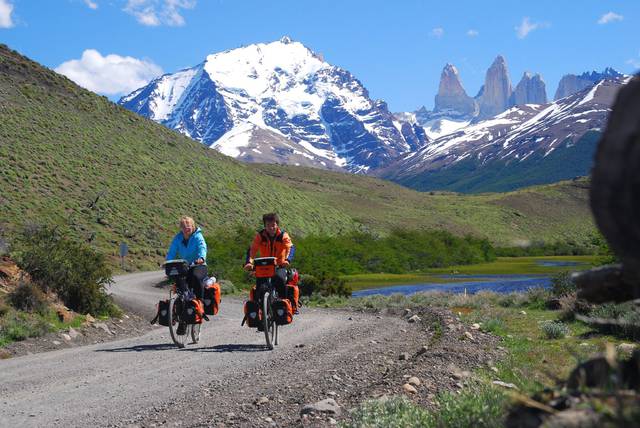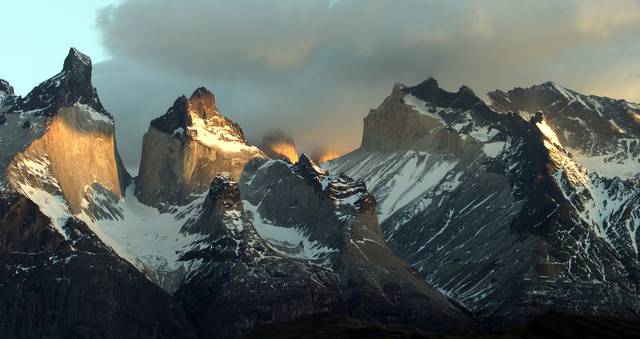

 Torres del Paine is a national park in Chilean Patagonia. It is in the southern tiers of the Andes and features mountains, lakes, and glaciers.
Torres del Paine is a national park in Chilean Patagonia. It is in the southern tiers of the Andes and features mountains, lakes, and glaciers.
The Torres del Paine (Spanish for "Towers of Paine" and "Paine" is an old indigenous word for the color blue), three immense rock towers, give the park its name.
Other attractions include the Cuernos del Paine (Spanish for "Horns of Paine" -- horn-like mountain tops), Grey Glacier, Lago Grey, Lago Pehoé, Lago Nordenskjöld, and Lago Sarmiento.
The towers are eroded remains of an uplifted region, this created by granite plutons that uplifted overlaying sedimentary layers of which the lowest is a dark red shale. On the southern side the overlying materials have been completely eroded, leaving only several tall, rounded granitic towers - these are the actual towers of the park. On the northern side, some of the original materials remain and as these have different slope and color, form the tips of the "horns" seen in the image above. At times in the distant past the area was extensively glaciated; some glaciers remain on the eastern side of the uplift (to the left in the image) and form icebergs that flow some distance into the large and scenic Lake Pehoé.
According to the studies made to the Paleo-Indian artifacts found in the surroundings of the park, the are must have been inhabited some 12,000 years ago. The Tehuelche Indians, descendants of the Paleo-Indians gave the name of Paine to the Massif, which meant "blue" in their language.
Lady Florence Dixie, in her book published in 1880, gave one of the first descriptions of the area and referred to the three towers as Cleopatra's Needles. She and her party are sometimes credited as being the first "foreign tourists" to visit the area that is now called Torres del Paine National Park.
Several European scientists and explorers visited the area in the following decades, including Otto Nordenskiöld, Carl Skottsberg, and Alberto María de Agostini.
The park was established in 1959 as Parque Nacional de Turismo Lago Grey (Grey Lake National Tourism Park) and was given its present name in 1970.
In 1976, British mountaineer John Gardner and two Torres del Paine rangers, Pepe Alarcon, and Oscar Guineo pioneered the Circuit trail which circles the Paine massif.
In 1977, Guido Monzino donated 12,000 hectares (30,000 acres) to the Chilean Government when its definitive limits were established. The park was designated a World Biosphere Reserve by the UNESCO in 1978.
In 1985, a tourist started a fire that burned about 150sqkm of the park. The blaze affected the areas east and south around Lake Pehoé.
In February 2005, an accidental fire started by a Czech backpacker, which lasted for about ten days, destroyed 155sqkm of the park, including about 2 km² of native forest. The Czech government offered aid after the fire and donated US$ 1 million to reforestation efforts.
In late December 2011 through January 2012, a fire blamed on an Israeli backpacker burned about 176sqkm of the reserve, destroying about 36 km² of native forest and affecting most of the areas around Lake Pehoé and the western areas around Lake Sarmiento, but moving away from the Cordillera del Paine, the park's centerpiece. The Israeli government sent reforestation experts to the zone, and has committed to donate trees to replant the affected areas.
Nevertheless, recent paleoenvironmental studies performed within the park indicates that fire have been a frequent phenomena at least during the last 12,800 years.
Beside the astonishing Paine massif and its beautiful peaks, azure lakes, trails that meander though emerald forests, roaring rivers you are to cross on rickety bridges and radiant blue glaciers, not to mention the vast openness of the steppe to rugged mountain terrain topped by looming peaks.
Fauna include abundant guanacos, flamingos, pumas, ñandu, gray fox and andean condors.
According to the Köppen climate classification, the park lies in the “temperate climate of cold rain without a dry season." The meteorological conditions of the park are variable due to the complex orography. But you have to be prepared for harsh weather. Wind and strong sun are also issues, and the weather can go through a full four seasons in the course of a day, as locals say.
The zone is characterized by cool summers, with temperatures lower than 16 °C (61 °F) during the warmest month (January). Winter is relatively cold, with an average high temperature in July of 5 °C (41 °F), and an average low of −3 °C (27 °F).[17]
The rainiest months are March and April, with a monthly average rainfall of 80 mm. This represents double the July–October (winter) rainfall, which are the drier months. A study of the exact chemical components of the precipitation in the park has been carried out.
During the high season (October to April) a CLP$21,000 entrance fee is collected on entrance for foreigners and a CLP$6,000 entrance fee is collected for Chilean citizens and residents, which means, if you are in Chile as an exchange student or working for a period of time, just show your Cédula de Identidad (Identity card given by the Civil Registry and Identification Service (Servicio de Registro Civil e Identificación)) to pay the resident entry fee.
In the low season (May to September) foreigners pay CLP$11,000 and Chilean citizens and residents CLP$4,000.
- Torres del Paine. The lookout, Base de las Torres, is a 45-minute hike from Campamento Torres
- Valle Francés. Accessed from Campamento Italiano, three hour hike one way.
- John Gardner Pass. Between Camping Los Perros and Campamento Paso, the John Gardner Pass is the point between the Valle de Los Perros (Valley of the Dogs) and the backside of the Circuit, and Glacier Grey.
- Glacier Grey. The Glacier Grey can be seen via a short hike out onto a sandbar from Guardería Grey, from the John Gardner Pass, or from Refugio Grey on the "W".
- Lago Sarmiento. A large pretty lake with distinctive white banks, a result of calcium deposits.
Torres del Paine. The lookout, Base de las Torres, is a 45-minute hike from Campamento Torres
Valle Francés. Accessed from Campamento Italiano, three hour hike one way.
John Gardner Pass. Between Camping Los Perros and Campamento Paso, the John Gardner Pass is the point between the Valle de Los Perros (Valley of the Dogs) and the backside of the Circuit, and Glacier Grey.
Glacier Grey. The Glacier Grey can be seen via a short hike out onto a sandbar from Guardería Grey, from the John Gardner Pass, or from Refugio Grey on the "W".
Lago Sarmiento. A large pretty lake with distinctive white banks, a result of calcium deposits.
- W Trek. Bus to Visitors Centre/Administration, hike via Campamento Las Carretas to Refugio Paine Grande (17.5 km), sleep first night there, Hike to Refugio Grey or Campamento Las Guardas (beautiful view of Grey Glacier) and back to Refugio Paine Grande (15 km), sleep at Refugio Paine Grande, hike to Campamento Italiano (7.6 km), sleep there, hike to Campamento Britanico and the Mirador of Vallé Frances (beautiful view on the snow-covered summits) and back (15 km), sleep at Campamento Italiano, hike to Hosteria Las Torres (16.5 km), sleep there, hike to Campamento Torres and Mirador Torres (beautiful view of the three torres) and back (10 km). Minibus to the Laguna Amarga park gate.
- Paine Massif "O" Circuit. Connects the two ends of the W via Camping Los Perros, Refugio Dickson, and Camping Serón, passing through the John Gardner Pass. 123 km in total, 6-10 days.
W Trek. Bus to Visitors Centre/Administration, hike via Campamento Las Carretas to Refugio Paine Grande (17.5 km), sleep first night there, Hike to Refugio Grey or Campamento Las Guardas (beautiful view of Grey Glacier) and back to Refugio Paine Grande (15 km), sleep at Refugio Paine Grande, hike to Campamento Italiano (7.6 km), sleep there, hike to Campamento Britanico and the Mirador of Vallé Frances (beautiful view on the snow-covered summits) and back (15 km), sleep at Campamento Italiano, hike to Hosteria Las Torres (16.5 km), sleep there, hike to Campamento Torres and Mirador Torres (beautiful view of the three torres) and back (10 km). Minibus to the Laguna Amarga park gate.
Paine Massif "O" Circuit. Connects the two ends of the W via Camping Los Perros, Refugio Dickson, and Camping Serón, passing through the John Gardner Pass. 123 km in total, 6-10 days.
- Drop off at Administration, Mirador Condor, Salto Grande, Mirador Cuernos, Mirador del Nordenskjold. Catch the bus at Laguna Amarga.
- Drop off at Laguna Amarga, shuttle to Hosteria Las Torres, hike to Campamento Torres and Mirador Torres and back (10 km). Shuttle to Laguna Amarga.
- Drop off at Pudeto, by catamaran to Refugio Paine Grande, return by the same catamaran.
- Sightseeing tour by boat on Lago Grey to the Grey glacier.
Although it is possible to follow the well-marked trails through the park without assistance, the experience is greatly enhanced by joining a guided tour. The guide will point out and name flora and fauna along the way, as well as making side detours to points of interest that the casual traveler might miss. The biggest advantage is that all equipment, such as tents, sleeping bags, mattresses, crampons for walking on ice and luggage transfers, are all provided by the tour companies.
Most companies run longer tours into the park and these are generally between five to seven days duration. Many companies run comprehensive tours with local knowledgeable guides, many of them following the famous "W" trek, and including a cruise up the Serrano River or along one of the fjords.
Depending on the tour, accommodations are provided in tents (either in pay campsites with all facilities, including hot showers, or in the free Conaf campsites with pit latrines), in the park's refugios listed above, or in lodges or remote mountain inns.
Other activities offered on guided tours include fly-fishing, kayaking through the fjords and channels, or ice hiking.
Hotel Las Torres has a gift shop in the park. There is another one at Pehoé Camping, 30 minutes walk south of the Pudeto bay on the shores of Pehoé lake.
Refugio Paine Grande has the only combination bar/restaurant on the W trek. Provisions can be expensively restocked at Refugio Grey, Refugio Chileno, and Refugio Los Cuernos. There is a small kiosk at Hotel Las Torres at the beginning of the trek to Las Torres. At Pudeto a small cafeteria is available and convenient to those awaiting the catamaran departure.
The only bar on the W trek is located at Refugio Paine Grande. Hotel Las Torres Patagonia has a nice bar. The menu includes salads and finger food.
Foxes have been known to steal food and belongings, and to bite people, particularly small children. Even among the normally temperamental weather typical in Patagonia, the weather in the John Gardner Pass can be particularly tricky.
